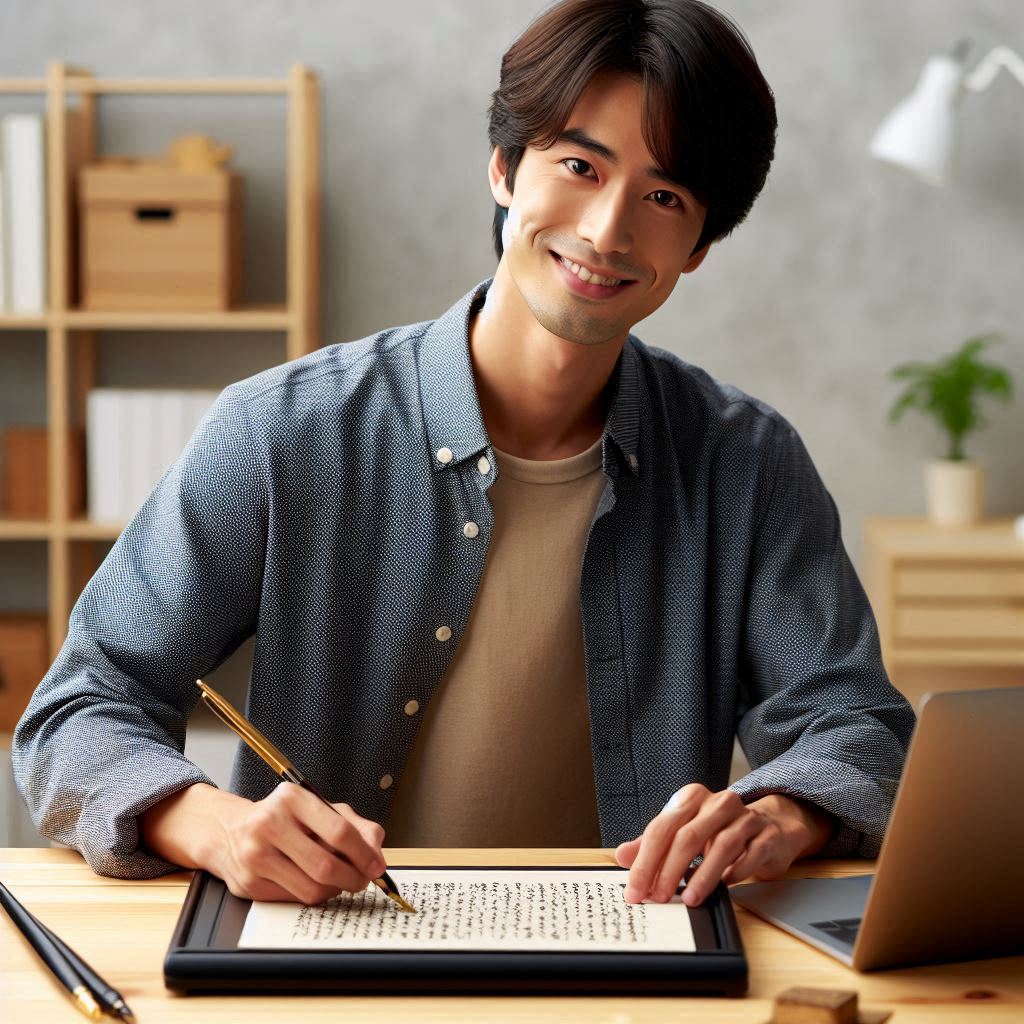Introduction
Calligraphy is the art of beautiful writing, where skilled artists create visually stunning letters and words.
Calligraphers play a crucial role in preserving cultural heritage and history through their works.
As we delve into the lives and works of famous calligraphers, we gain insight into the rich tapestry of human expression.
Wang Xizhi, known as the “Sage of Calligraphy,” was a Chinese calligrapher from the 4th century.
His masterpiece, the “Lantingji Xu,” is considered a pinnacle of Chinese calligraphy, showcasing his mastery of brush techniques and artistic expression.
Yun Shouping, a celebrated calligrapher from the Qing Dynasty, was known for his graceful and elegant style.
His works, such as “Orchid Pavilion Preface,” exemplify the delicate balance between form and expression in calligraphy.
Sei Shonagon, a Japanese court lady and poet from the Heian period, was revered for her exquisite calligraphy.
Her diary, “The Pillow Book,” reflects her impeccable handwriting and artistic sensibilities, capturing the beauty of the written word.
By exploring the works of famous calligraphers like Wang Xizhi, Yun Shouping, and Sei Shonagon, we gain a deeper appreciation for the art of calligraphy and its profound impact on culture and history.
These iconic figures continue to inspire and enrich our understanding of the beauty of language and visual expression.
Ancient Calligraphers
Ancient calligraphers like Wang Xizhi and Ouyang Xun
Calligraphy, a revered art form, flourished in ancient China through the skills of notable calligraphers.
Wang Xizhi and Ouyang Xun stand out among them, shaping the art’s evolution.
Their iconic works such as the “Orchid Pavilion Preface”
Wang Xizhi, known as the “Sage of Calligraphy,” lived during the Eastern Jin dynasty.
His most famous work, the “Orchid Pavilion Preface,” showcases his mastery.
This piece, composed in 353 AD, captures the essence of nature and human emotion.
It expresses a deep appreciation for friendship and the fleeting beauty of life.
Scholars regard it as a pinnacle of Chinese calligraphy.
Ouyang Xun, a prominent calligrapher of the Tang dynasty, also made significant contributions.
His style emphasizes clarity and strength.
Transform Your Career Today
Unlock a personalized career strategy that drives real results. Get tailored advice and a roadmap designed just for you.
Start NowOuyang‘s work includes the “Thousand Character Classic,” a text that illustrates his skill.
His characters are bold and expressive, demonstrating a disciplined approach to calligraphy.
Significance of their contributions to the development of calligraphy
The significance of these ancient calligraphers extends beyond their individual works.
Wang Xizhi‘s fluid style influenced generations of artists, establishing standards for artistic expression.
His innovative techniques encouraged others to experiment with brushwork and composition.
Ouyang Xun‘s emphasis on structure laid the groundwork for future calligraphers.
His rigorous approach transformed calligraphy into a respected academic discipline.
Both calligraphers’ legacies remain evident in contemporary practices.
Their contributions to calligraphy helped solidify its status as a vital cultural heritage.
Today, artists and enthusiasts continue to draw inspiration from their iconic works.
As we appreciate their artistry, we honor the enduring impact of Wang Xizhi and Ouyang Xun on calligraphy‘s rich history.
Their influence transcends time, reminding us of the beauty and significance of this ancient art form.
Read: How to Build a Glass Art Portfolio
Islamic Calligraphers
Islamic calligraphy is a profound art form that embodies beauty and spirituality.
Notable calligraphers like Ibn Muqla and Mir Ali Tabrizi significantly contributed to this tradition.
Calligraphers Like Ibn Muqla and Mir Ali Tabrizi
Ibn Muqla, a 10th-century master, is known as the father of Arabic calligraphy.
He established the principles of proportion and geometry in writing.
His systematization laid the groundwork for future calligraphers.
Mir Ali Tabrizi, a 16th-century artist, further refined these techniques.
He created the famed Naskh style, known for its elegance and readability.
Transform Your Career Today
Unlock a personalized career strategy that drives real results. Get tailored advice and a roadmap designed just for you.
Start NowBoth calligraphers are revered for their dedication and creativity.
Exploration of Their Masterpieces
Ibn Muqla‘s masterpieces include stunning Quranic verses.
His works often feature intricate designs and precise lettering.
These pieces serve as spiritual expressions, capturing the essence of the text.
Mir Ali Tabrizi‘s poetic inscriptions showcase his skill and artistry.
He beautifully blended verses with visual aesthetics, enhancing the meaning of the words.
His calligraphy is still celebrated for its artistic grace.
Influence of Islamic Calligraphy on Arabic Art and Design
Islamic calligraphy significantly influences Arabic art and design.
It transcends mere writing to become a form of visual art.
Calligraphers incorporate their work into architecture, textiles, and ceramics.
The intricate patterns enhance the beauty of various objects and spaces.
This fusion of calligraphy with design has inspired generations of artists.
It continues to shape contemporary art in the Islamic world.
In short, the contributions of Ibn Muqla and Mir Ali Tabrizi profoundly impacted Islamic calligraphy.
Their masterpieces not only enriched the literary landscape but also transformed artistic expressions.
The legacy of Islamic calligraphy endures, inspiring future generations to explore this beautiful art form.
Read: Glass Art Installation Ideas for Homes
Japanese Calligraphers
Introduction to calligraphers like Yamaoka Tesshu and Seshu
Japanese calligraphy, or “shodo,” blends art and spirituality.
Renowned calligraphers like Yamaoka Tesshu and Seshu have left significant legacies.
Their works embody beauty and depth, capturing the essence of Japanese culture.
Transform Your Career Today
Unlock a personalized career strategy that drives real results. Get tailored advice and a roadmap designed just for you.
Start NowShowcase of their famous works such as “Enso” and “Rokkasyo”
Yamaoka Tesshu (1836-1888) was a master of brushwork.
He practiced Zen Buddhism, which deeply influenced his art.
His most famous piece, the “Enso,” symbolizes enlightenment.
This simple circle conveys profound meaning, reflecting the artist’s state of mind.
Seshu (1420-1506) was another iconic figure.
He excelled in ink wash painting and calligraphy.
His notable work, “Rokkasyo,” displays fluid brush strokes.
This piece showcases his mastery of composition and rhythm, drawing viewers into its dynamic energy.
The spiritual and meditative aspect of Japanese calligraphy
Both calligraphers embraced the spiritual aspect of their craft.
Shodo serves as a form of meditation, promoting mindfulness.
Each stroke requires focus and intention, allowing artists to connect with their inner selves.
This practice cultivates tranquility and clarity of thought.
The act of writing becomes a meditative ritual.
Calligraphers channel their emotions and thoughts through their brushes.
The physical movement embodies their spirit, making each piece unique.
Japanese calligraphy also emphasizes the importance of simplicity.
The beauty lies in the elegance of minimalism, echoing Zen principles.
Calligraphers aim to capture the essence of their subjects without excessive detail.
In a nutshell, Japanese calligraphers like Yamaoka Tesshu and Seshu transformed their art into a spiritual journey.
Their iconic works, such as “Enso” and “Rokkasyo,” continue to inspire.
Transform Your Career Today
Unlock a personalized career strategy that drives real results. Get tailored advice and a roadmap designed just for you.
Start NowThrough the meditative practice of calligraphy, they convey deep meanings, inviting us to explore our own creativity and mindfulness.
Read: How to Build a Calligraphy Business Online

Contemporary Calligraphers
Modern calligraphers like Yukimi Annand and Pokras Lampas
Contemporary calligraphy thrives with artists like Yukimi Annand and Pokras Lampas leading the way.
They blend traditional techniques with modern influences, creating unique works.
Yukimi Annand is known for her captivating brush lettering.
She infuses a sense of movement into her pieces, using fluid strokes.
Her work often features vibrant colors and intricate details, drawing viewers in.
Annand‘s artistic journey reflects her passion for combining cultural elements with contemporary aesthetics.
Their innovative styles and techniques
Pokras Lampas takes a different approach.
He explores large-scale murals and urban environments, pushing the boundaries of calligraphy.
His signature style merges traditional calligraphy with modern graffiti influences.
Lampas often collaborates with street artists, enhancing his visual language through diverse techniques.
Comparison between traditional and contemporary calligraphy practices
Both calligraphers innovate while respecting their craft‘s roots.
Annand emphasizes the beauty of letters, while Lampas challenges the conventional form.
Their unique styles showcase the versatility of contemporary calligraphy.
The techniques used by these artists illustrate the evolution of calligraphy.
Annand employs brush pens, experimenting with varying pressure to create dynamic lines.
She also incorporates digital tools, expanding her creative possibilities.
Lampas, on the other hand, uses spray paint and markers for bold, expressive strokes.
His approach highlights the adaptability of calligraphy in urban settings.
Transform Your Career Today
Unlock a personalized career strategy that drives real results. Get tailored advice and a roadmap designed just for you.
Start NowWhen comparing traditional and contemporary practices, distinct differences emerge.
Traditional calligraphy focuses on precision and discipline.
It often adheres to specific scripts and techniques developed over centuries.
In contrast, contemporary calligraphy embraces experimentation and personal expression.
Artists today freely blend styles, pushing boundaries beyond the classical norms.
Basically, contemporary calligraphers like Yukimi Annand and Pokras Lampas redefine the art form.
They inspire future generations to explore calligraphy‘s limitless potential.
By merging tradition with innovation, they keep the art alive and evolving.
Read: Advanced Techniques in Glass Blowing
Chinese Calligraphers
Focus on calligraphers such as Qi Baishi and Zhao Mengfu
Chinese calligraphy boasts a rich history, with masters like Qi Baishi and Zhao Mengfu shaping its legacy.
Qi Baishi, active in the 20th century, was renowned for his vibrant and expressive style.
His artworks often depicted nature, embodying a sense of vitality and movement.
One of his most famous pieces is “Dwelling in the Fuchun Mountains,” where he captures the essence of serene landscapes.
This painting exemplifies his mastery in blending calligraphy with traditional painting techniques.
Their renowned artworks like “Dwelling in the Fuchun Mountains” and “Orchid Pavilion Gathering”
Zhao Mengfu, a 13th-century calligrapher, was influential in reviving classical styles.
His work “Orchid Pavilion Gathering” reflects his deep appreciation for tradition and nature.
Zhao’s elegant brushwork and refined characters showcase the beauty of Chinese script.
He emphasized the harmony between calligraphy and visual art, leaving a lasting impact on future generations.
The influence of Chinese calligraphy on painting and literature
The influence of Chinese calligraphy extends beyond visual art.
It plays a significant role in literature, enriching poetry and prose.
Transform Your Career Today
Unlock a personalized career strategy that drives real results. Get tailored advice and a roadmap designed just for you.
Start NowCalligraphers often used their skills to enhance literary works, transforming words into art.
This fusion elevates both forms, creating a deeper appreciation for language and aesthetics.
Moreover, calligraphy serves as a medium for cultural expression.
It conveys emotions, thoughts, and philosophies inherent in Chinese culture.
The delicate strokes and characters reflect the calligrapher’s personality and intent.
As a result, each piece becomes a unique blend of art and literature.
All in all, Qi Baishi and Zhao Mengfu exemplify the profound impact of Chinese calligraphy.
Their iconic works, like “Dwelling in the Fuchun Mountains” and “Orchid Pavilion Gathering,” continue to inspire artists today.
The integration of calligraphy with painting and literature highlights its enduring significance in Chinese heritage.
Through these masters, we witness the beauty of calligraphy as a vital cultural expression.
Learn More: Art Therapy vs. Traditional Therapy: Key Differences
Learn More: Tips for Successful Game Art and Design
Western Calligraphers
Prominent Western calligraphers like Edward Johnston and Hermann Zapf
Western calligraphy has a rich history, marked by the contributions of notable artists.
Edward Johnston and Hermann Zapf stand out among them.
Edward Johnston is often regarded as the father of modern calligraphy.
His work on the London Underground map revolutionized public signage.
Johnston’s typeface, created in 1916, was designed for clarity and functionality.
His emphasis on legibility set new standards in graphic design.
Their iconic works such as the London Underground map and Palatino typeface
Hermann Zapf followed in Johnston‘s footsteps, expanding the boundaries of type design.
He created the Palatino typeface in 1948, which remains popular today.
Transform Your Career Today
Unlock a personalized career strategy that drives real results. Get tailored advice and a roadmap designed just for you.
Start NowPalatino showcases elegant letterforms that balance beauty and readability.
Zapf‘s influence extended beyond typefaces; he also advocated for the art of calligraphy.
Both Johnston and Zapf demonstrated the importance of integrating art with practicality.
Their works exemplify how calligraphy can enhance everyday communication.
They showed that beautiful lettering could be both artistic and functional.
The evolution of Western calligraphy styles over time
Over time, Western calligraphy styles have evolved significantly.
Early manuscripts featured ornate scripts, reflecting the influence of Gothic styles.
As the Renaissance emerged, calligraphy shifted toward more humanist forms.
This transition marked a move towards simpler, more legible scripts.
The 20th century introduced new techniques and materials.
Artists began experimenting with modern tools, leading to innovative styles.
Digital technology also transformed calligraphy, allowing for new creative possibilities.
Today, Western calligraphy continues to thrive.
Contemporary calligraphers draw inspiration from historical styles while incorporating modern elements.
This blend of old and new keeps the art form relevant and dynamic.
Essentially, the contributions of Edward Johnston and Hermann Zapf significantly shaped Western calligraphy.
Their iconic works highlight the enduring impact of this art form.
The evolution of styles illustrates a vibrant tradition that continues to inspire.
Learn More: Best Colleges for Industrial Design in the USA
Female Calligraphers
Recognition of female calligraphers like Madinah Javed and Pan Yu-Lin
Calligraphy has historically been male-dominated, but female calligraphers have made remarkable contributions.
Transform Your Career Today
Unlock a personalized career strategy that drives real results. Get tailored advice and a roadmap designed just for you.
Start NowNotable figures include Madinah Javed and Pan Yu-Lin.
Their works exemplify skill and creativity, elevating the art form.
Madinah Javed, a Pakistani calligrapher, blends traditional techniques with contemporary styles.
She incorporates vibrant colors and modern themes, creating stunning pieces that resonate with diverse audiences.
Her work challenges stereotypes and showcases the depth of female artistry in calligraphy.
Pan Yu-Lin, a renowned Chinese calligrapher, brings a unique perspective to the craft.
She emphasizes the connection between calligraphy and Chinese culture.
Pan‘s intricate brushwork reflects her deep understanding of traditional methods, making her a vital figure in modern calligraphy.
Appreciation of their unique perspectives and contributions to the art of calligraphy
The contributions of female calligraphers extend beyond technique.
They introduce new themes and ideas, enriching the art form.
Their voices and experiences inspire others, fostering a more inclusive artistic community.
Despite their achievements, female calligraphers face significant challenges.
The calligraphy world often overlooks women, perpetuating gender biases.
Many female artists struggle for recognition and opportunities in exhibitions and competitions.
Moreover, societal expectations can hinder their artistic expression.
Balancing personal life and professional aspirations poses additional obstacles.
Yet, many female calligraphers persevere, driven by their passion for the art.
Reflection on the Challenges Faced by Female Calligraphers in a Traditionally male-dominated field
In recognizing female calligraphers, we celebrate their creativity and resilience.
Their stories highlight the importance of diversity in the art world.
As we appreciate their unique contributions, we pave the way for future generations of female artists.
Transform Your Career Today
Unlock a personalized career strategy that drives real results. Get tailored advice and a roadmap designed just for you.
Start NowBy supporting and promoting female calligraphers, we foster an environment where all voices are heard.
This recognition can inspire more women to pursue their passion for calligraphy, enriching the art for everyone.
Throughout history, calligraphy has predominantly been a male-dominated field.
However, there are notable female calligraphers who have made significant contributions to the art form.
Delve into the Subject: Understanding Creative Director’s Role in Marketing
Conclusion
Calligraphy is an art form that has been practiced for centuries, with famous calligraphers leaving behind iconic works that continue to inspire and influence artists today.
Let’s take a closer look at some of these renowned figures and their contributions.
Known as the “Sage of Calligraphy,” Wang Xizhi is considered one of the greatest calligraphers in Chinese history.
His most famous work is the “Preface to the Poems Composed at the Orchid Pavilion.”
A prominent Ottoman calligrapher, Sheikh Hamdullah is known for his mastery of the Thuluth script.
His work can be seen in the Topkapi Palace Museum in Istanbul.
A Ming dynasty calligrapher, Wang Duo is celebrated for his elegant and refined style.
His masterpiece, “Orchid Pavilion Preface in Regular Script,” is admired for its precision and beauty.
Considered the father of modern calligraphy, Edward Johnston’s influence can be seen in the development of the Johnston typeface and his book “Writing & Illuminating & Lettering.”
The diverse styles and influences of famous calligraphers highlight the rich history of this art form.
It is important to celebrate and preserve the legacy of these artists for future generations.
Aspiring calligraphers should feel encouraged to explore and experiment with different techniques and forms to continue the tradition of calligraphy.




